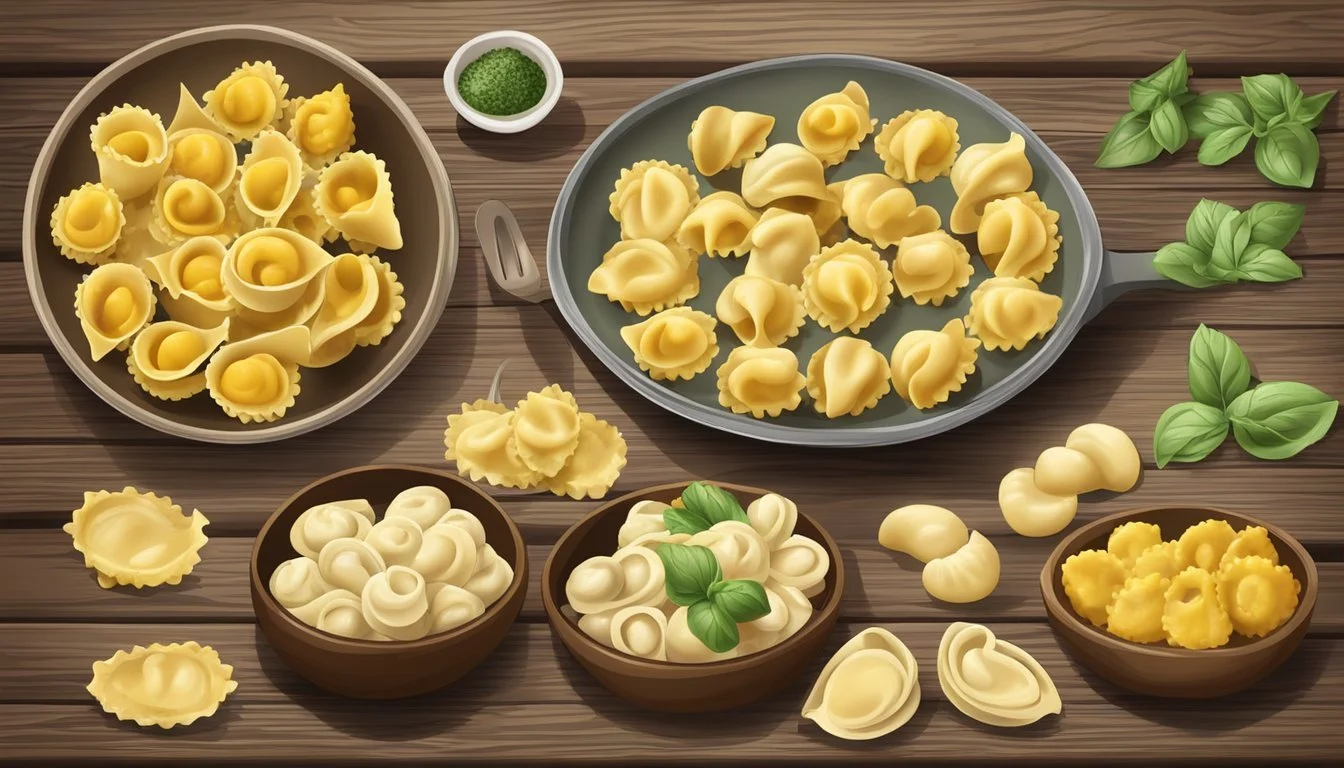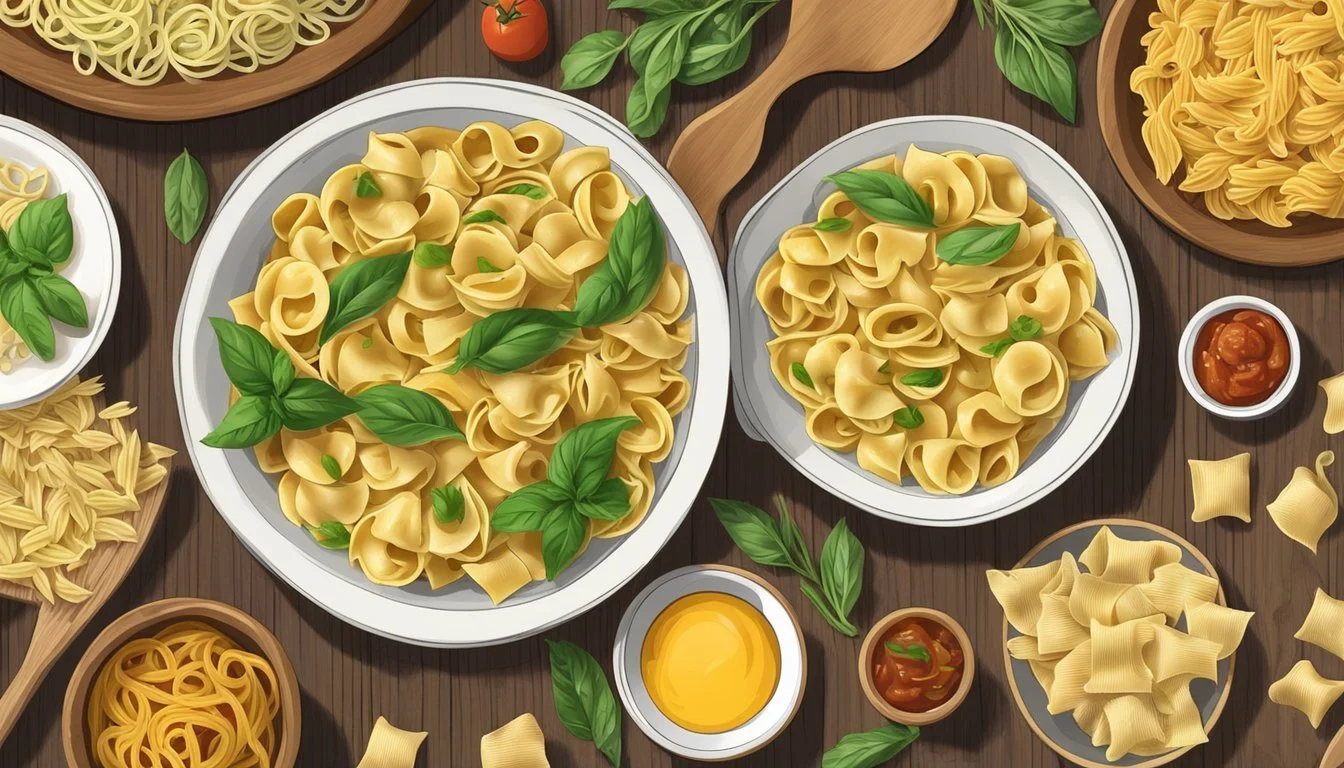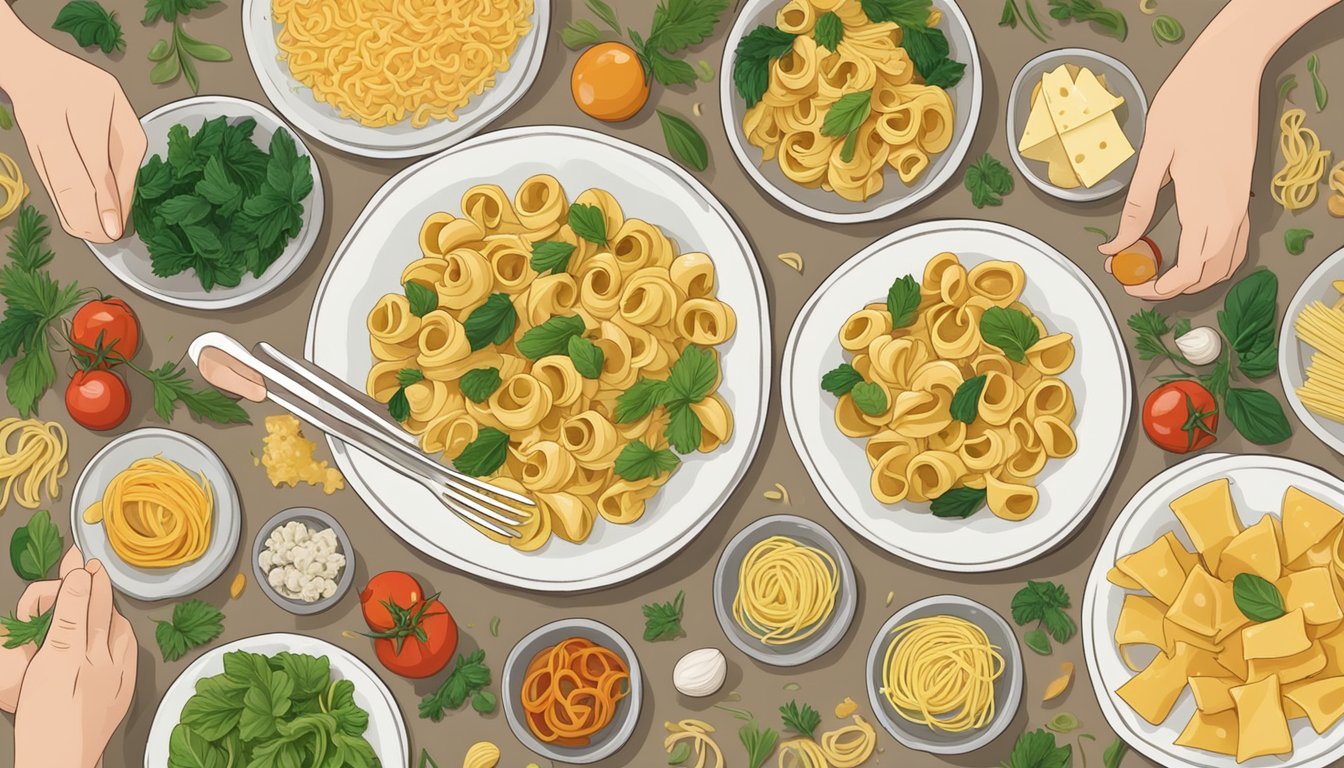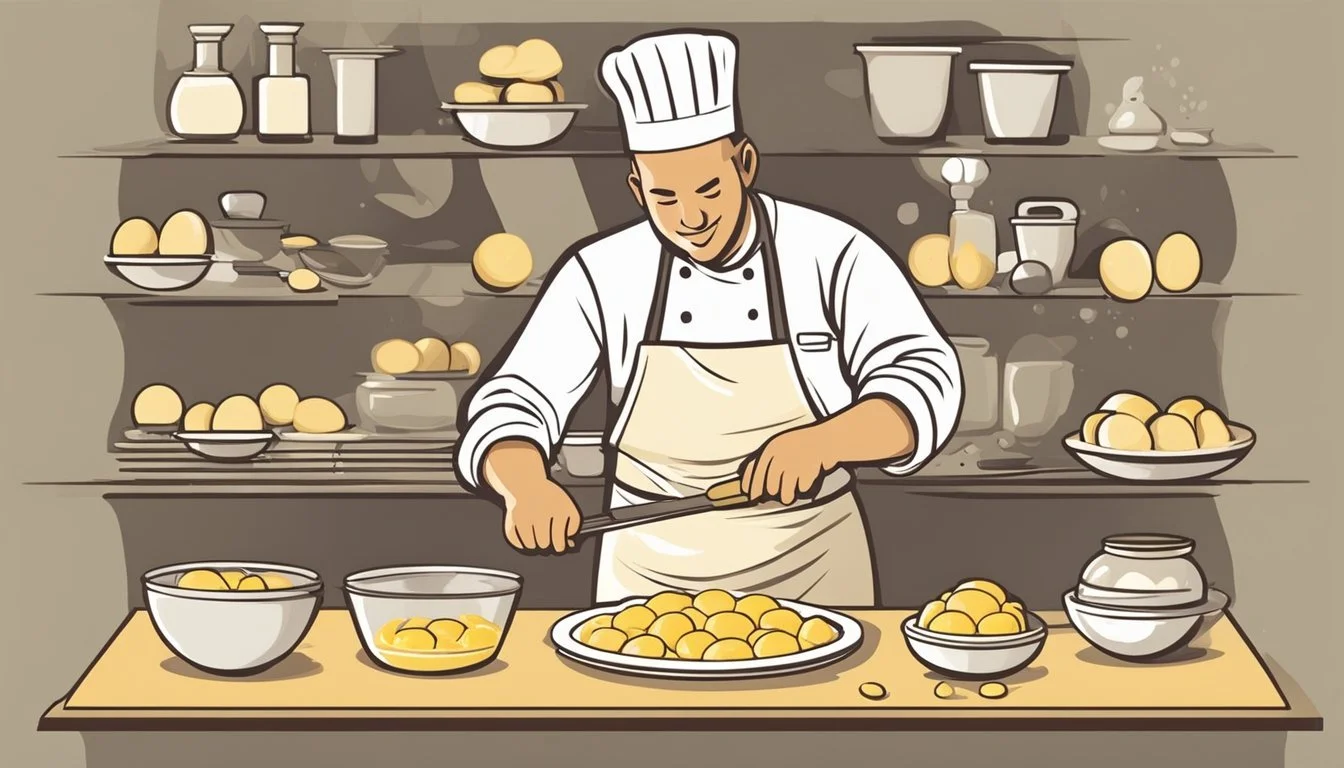Tortellini Pasta Substitutes
Top Alternative Noodle Choices
Tortellini, a beloved stuffed pasta (What wine goes well with pasta?) from the Italian region of Emilia-Romagna, is cherished for its distinctive ring shape and the delicious fillings it encapsulates, ranging from cheese to meat. Traditionally served in broth or with a sauce, this pasta has made a name for itself worldwide. However, dietary preferences or ingredient availability often necessitate the search for suitable substitutes that maintain the essence of a true tortellini dish.
When considering alternatives to tortellini, the market offers several pasta substitutes that can mimic the heartiness and texture of this Italian staple. Options such as ravioli share the filled characteristic, offering a similar bite and versatility in fillings. For those looking to reduce carbohydrates or gluten in their diet, a variety of non-traditional pasta made from vegetables or legumes provides a nutritious yet satisfying experience. These choices allow for the recreation of the classic tortellini structure and taste, ensuring that the foundational elements of the dish remain intact.
Exploring tortellini substitutes is not solely about replicating the original but also about discovering new culinary landscapes. One can find creative solutions in the kitchen by using rice noodles, spiralized vegetables, or other pasta shapes. Each substitute brings its unique flair to dishes, whether in texture, flavor or nutritional content, opening the door to a range of possibilities for both traditional and innovative Italian-inspired meals.
Understanding Tortellini
Tortellini, a traditional stuffed pasta from the Emilia-Romagna region, is renowned for its distinctive ring shape and rich fillings. This section delves into the traditional ingredients that make up tortellini, its nutritional aspects, and its culinary importance.
Traditional Ingredients
Tortellini is meticulously crafted, often with an egg-enriched pasta dough that gives it a tender texture. The fillings usually contain a blend of high-quality cheese, such as Parmigiano Reggiano, combined with meat like mortadella or prosciutto, finely ground and seasoned with nutmeg for added depth of flavor. This stuffed pasta encapsulates the essence of its origin through these authentic ingredients.
Pasta Dough: Typically made from flour, eggs, and salt.
Filling:
Cheese: Parmigiano Reggiano is a staple.
Meat: Mortadella and prosciutto are traditional choices.
Seasoning: Nutmeg adds a unique flavor profile.
Nutritional Profile
Tortellini provides a balanced nutritional profile, combining complex carbohydrates from the pasta with proteins and fats from the egg-based dough and rich filling. However, due to the use of premium cheeses and meats, they can be high in calories and should be enjoyed in moderation as part of a balanced diet.
Nutrient Content Carbohydrates High Proteins Moderate Fats Moderate Calories High
Culinary Significance
Tortellini is more than just a pasta dish; it is a culinary symbol of the Emilia-Romagna region, often served in a broth or with a cream sauce. Its size and shape not only contribute to its aesthetic appeal but also to its texture and capacity to hold the sumptuous filling. Tortellini's revered status also stems from its versatility in various recipes and its ability to carry the rich history of Italian pasta-making traditions.
Factors to Consider When Choosing Substitutes
When selecting alternatives for tortellini pasta, individuals should account for their taste preferences, health requirements, and nutritional goals. These criteria ensure the substitute chosen satisfies cravings, adheres to dietary limits, and contributes positively to one's diet.
Taste and Texture Preferences
Choosing a substitute for tortellini pasta largely depends on an individual's desire for a similar taste and mouthfeel. Fresh alternatives may include stuffed pastas such as ravioli for those seeking a texture akin to the original filled pasta. For a similar bite, options like ricotta-stuffed shells could be ideal. Whereas, those looking for low-carb or gluten-free options might opt for zucchini made into spirals or "zoodles," which offer a different texture but can be a pleasing alternative when paired with the right sauce.
Dietary Restrictions
For individuals with dietary restrictions, finding an appropriate pasta substitute can be particularly critical to their health and well-being. Those with gluten intolerance or celiac disease should opt for gluten-free alternatives, such as rice flour or quinoa-based pastas. Here, the key is to scrutinize the ingredients list to avoid any gluten-containing products. For people with diabetes, controlling carbohydrate intake is vital, hence low-carb substitutes like shirataki noodles can be a practical choice.
Nutritional Goals
Nutritional content is another primary factor for consideration, especially for those focused on weight loss or general health benefits:
Calories: Substitutes like spaghetti squash or shirataki noodles are lower in calories compared to traditional pasta, which can be conducive to weight loss goals.
Fiber: Some may seek a high-fiber alternative to support digestive health. In this case, choosing a substitute like whole-grain or legume-based pasta could be beneficial.
Low-Carb: Typically, lighter substitutes such as vegetable spirals or legume-based pastas provide lower carbohydrate content, which is often desired by individuals aiming to reduce their carb intake.
By keeping in mind these factors, consumers can make informed decisions that align with their culinary preferences and health objectives.
Pasta Substitute Options
When exploring alternatives to traditional tortellini pasta, one can find options that cater to gluten-free diets, reduce carbohydrate intake, or incorporate more vegetables into meals.
Gluten-Free Alternatives
Gluten-free alternatives are essential for those with celiac disease or gluten sensitivity. Substitutes such as brown rice pasta and soba noodles provide the pasta experience without the gluten found in wheat flour. Brown rice pasta, made from brown rice, offers a similar texture and taste to traditional pasta, while soba noodles, crafted from buckwheat, are a hearty Japanese staple.
Brown Rice Pasta: Comes in various shapes to mimic traditional pasta.
Soba Noodles: Offer a nuttier flavor and firm texture.
Low-Carb Alternatives
For individuals seeking to lower their carbohydrate intake, bean pasta and kelp noodles present suitable options. Bean pastas are typically made from legumes like chickpeas or lentils, providing a high-protein, low-carb alternative. Kelp noodles are made from seaweed and are virtually carb-free.
Bean Pasta: High in protein, various legume-based options available.
Kelp Noodles: Minimal carbs, serve as a light substitute.
Veggie-Based Alternatives
Vegetables can be transformed into pasta-like alternatives, offering a nutrient-dense and low-carb option. Spiralized vegetables such as zucchini, butternut squash, and cauliflower can stand in for tortellini noodles in many dishes.
Zucchini: Spiralized into 'zoodles', a popular and versatile pasta substitute.
Butternut Squash: Can be peeled into ribbons for a sweet, tender replacement.
Cauliflower: Riced or mashed, it provides a different texture reminiscent of dough-based pasta when used in baking.
Preparing Substitutes for Tortellini Pasta
When choosing substitutes for tortellini pasta, it’s essential to consider cooking techniques, sauces that complement the alternative pasta's texture, and fillings that align with the original dish's flavors.
Cooking Techniques
For alternatives like rice noodles or brown rice pasta, begin by boiling water in a large pot. Add a pinch of salt, then cook the noodles for the time specified on the package—usually between four to eight minutes depending on the thickness—until al dente. Drain promptly to prevent overcooking. For vegetables like spiralized carrots or zucchini, a quicker cooking time of one to two minutes is sufficient, followed by immediate draining.
Suitable Sauces
The richness and creaminess of traditional tortellini align well with butter- or cheese-based sauces such as Alfredo, which should be heated gently in a pan before tossing with the pasta substitute. For a lighter option, one can opt for a simple blend of olive oil, minced garlic, and herbs, heated until the garlic is fragrant. Tomato-based sauces work well too, especially when simmered with onions and herbs to enhance flavor.
Pairings & Fillings
Pair substitutes with ingredients often found in tortellini fillings, like spinach, mushrooms, and cheese to maintain the spirit of the dish. Meats such as ground beef or chicken can be cooked and seasoned before adding to the pasta. Vegetable options include sautéed bell peppers, roasted tomatoes, or steamed broccoli. Enhance the dish with fresh herbs like basil or parsley for a burst of flavor.
Nutritional Considerations
When considering alternatives to tortellini pasta, one should scrutinize the nutritional profile of those substitutes, especially in terms of caloric content, macronutrient balance, and micronutrient content. These aspects are crucial for those looking to maintain a specific diet or nutritional regimen.
Caloric Content
Substitutes for tortellini vary greatly in caloric content. Traditional tortellini is typically high in calories due to its rich filling and the pasta itself.
Zucchini Noodles: A cup has approximately 20 calories.
Shirataki Noodles: A serving contains as little as 10 calories.
Whole-Wheat Pasta: Offers a similar caloric range to regular tortellini but with better nutritional value.
Macronutrient Balance
Macronutrient profile is essential when substituting tortellini, particularly for individuals balancing their intake of protein, carbs, and fats.
Protein: Consider options like lentil pasta, which can provide up to 13 grams of protein per serving.
Carbs: Substitutes like shirataki noodles are very low in carbohydrates. In contrast, quinoa pasta is a higher-carb option but also includes a complete protein profile.
Fiber: Substitutes such as vegetable spirals can offer a higher fiber content, important for digestive health.
Micronutrient Content
The micronutrient content in pasta alternatives often includes an array of vitamins and minerals.
Vitamins: Substitutes like butternut squash noodles are an excellent source of vitamins A, C, and E.
Minerals: Options such as soba noodles can offer minerals like iron and magnesium.
Antioxidants: Whole grain and vegetable-based pasta substitutes can be rich in antioxidants, which contribute to neutralizing free radicals in the body.
Additional Cooking Tips
In this section, readers will find guidance on making the most of tortellini pasta substitutes through specialized techniques. The focus is on using a spiralizer to create vegetable noodles and working with alternative flours for those looking to tailor their pasta experience.
Using a Spiralizer
When the goal is to substitute traditional pasta with a vegetable-based alternative, using a spiralizer becomes an essential technique. Zucchini is an ideal choice due to its mild, neutral flavor and sturdy structure. It can be transformed into zucchini noodles using a spiralizer. These noodles offer a pasta-like experience with a significantly reduced cooking time. Here are steps for optimal results:
Select fresh, firm zucchini for evenly shaped noodles.
Attach the zucchini to your spiralizer, and twist to create noodles.
For best texture, sauté the noodles for 3-5 minutes, until al dente.
Working with Alternative Flours
Creating pasta dough with alternative flours extends the range of dietary preferences and needs that tortellini pasta can accommodate. Gluten-free flours, such as rice or chickpea flour, can be used to form pasta dough that is compatible with a pasta machine or rolled out manually. Consider these tips:
Mix alternative flours with a binding agent, such as xanthan gum, for elasticity.
Knead the dough thoroughly to ensure it holds together during cooking.
Begin with a small batch to adjust for texture and cooking time.
Conclusion
Choosing the right substitute for tortellini pasta depends on dietary preferences and desired textures. For a gluten-free alternative, rice noodles or shirataki noodles can be an excellent choice. When looking for a more nutrient-dense option, zucchini noodles—also known as "zoodles"—are popular due to their low carbohydrate content and ease of preparation.
Here is a comparison of common pasta substitutes:
Substitute Texture Flavor Compatibility Nutritional Benefit Zucchini Noodles Crunchy yet tender Neutral, works well with various sauces Low-carb, vitamin-rich Rice Noodles Soft, slightly chewy Mild taste, absorbs sauces well Gluten-free, versatile Shirataki Noodles Gelatinous, chewy Neutral, ideal for absorbing flavors Very low-calorie, gluten-free
When cooking with these alternatives, it’s important to remember that each one brings a unique consistency that may alter the end result of the dish. Often the success of the substitute lies in the preparation—zucchini noodles, for instance, should be cooked just until barely tender to preserve their texture.
In terms of the sauce, the neutrality of most pasta alternatives makes them quite adaptable. One can complement these substitutes with a range of sauces, from a rich and creamy option to a lighter, vegetable-based sauce, without losing the essence of the dish.
In summary, a successful pasta substitute should harmonize with the overall flavors of the traditional tortellini dish, offer a satisfying mouthfeel, and meet the dietary needs of the consumer. With a thoughtful choice, individuals can enjoy a delightful pasta-like experience while adhering to their nutritional goals or dietary restrictions.









